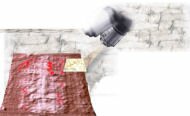
SHROUD SCIENCE GROUP INTERNATIONAL CONFERENCE
The Shroud of Turin: Perspectives on a Multifaceted Enigma
OHIO STATE UNIVERSITY BLACKWELL HOTEL
August 14 through August 17, 2008 Abstracts of Papers
A Note on “the Servant of Peter” by Diana Fulbright (). Saturday, August 16, 5:10 p.m.– 5:30 p.m.
The question is: did the Gospel of the Hebrews say (according to Jerome, in his De Viris Illustribus 2), “Now the Lord, when he had given the linen cloth to the servant of the priest, or is a restoration to an alternate reading: “ . . . to the servant of Peter” more plausible?
The argument for this alternate reading rests on an untenable substitution of Latin words for Hebrew words. One such suggestion follows:
“Since the Hebrew consonants for servant or slave are “ebed”... and “cohen” for priest, they are closely related to the Hebrew “kepha” for Peter and “yochanan” for John. This would be in total agreement with what Paul tells us in that, after the Resurrection, Jesus was first “seen of Cephas” (Peter). It also agrees with John’s Gospel account of Peter and John having found the linen clothes lying in the empty tomb.”
Another suggestion is that the vowels, not the consonants were responsible for the scribal error.
However, the emendation for the alternate reading would have to involve “Peter” replacing the “servant”, not the “priest” – i.e., “Petro” instead of “puero” (Latin for “servant”).
Jerome’s quotation (or paraphrase) from the Gospel of the Hebrews reads: “But the Lord, after giving the burial shroud to the priest’s servant, went to James and appeared to him.” To substitute “Peter” (Latin “Petro”) for “servant,” (Latin “puero”) the text would read, “the priest’s Peter,” making no sense at all!
Regarding the consonants: They would be:
slave/servant (“ebed”) Y-B-D. (Y=ayin) עבד
priest (“cohen”) K-H-N כהן
Peter* (“Kef” - rock) K-P – כפ
maybe K-P+cons., if that were a man’s name, which I doubt; I think it was more like a sort of joking nickname. *Peter’s Hebrew name was Shimon = ש’מן John (“Yochanan”) I-V-H-N-N ‘וחננ
Would Peter’s Hebrew name, SIMN, ש’מן, or his nickname, KP, כפ, likely be mistaken for כהן, KHN, “priest”? The letters do not correspond, and this is an untenable “solution” to a specious “restoration” that never should have been suggested in the first place.
Regarding the vowels: This idea involves not only the words analyzed above, but also the names “Cephas” and “Yochanan.” Cephas is English transliteration of Greek transliteration of Hebrew. Yochanan is another transliteration. But whatever Hebrew vowels might be involved, we have to reject this so-called “evidence” forthwith: Since vowels in Hebrew weren’t written down until about eight centuries later, this argument, too, goes nowhere.
An additional argument relies on the Gospel of John ( 20:5,6,7) which places Peter and another disciple in the tomb with the linens.
However, John clearly contradicts Jerome’s account, which states that Jesus presented the burial cloths to [someone] whereas they are seen lying in the tomb in the account of the fourth gospel. I think we can agree that the fourth gospel’s account must take precedence over a lost Gospel of the Hebrews of which we have only a few quoted or paraphrased lines.
The greater problem is that we are talking about a Latin translation involving Latin substitutions, but the Latin words in question do not correspond to the Hebrew words the scribe is supposed to have mistaken. According to Jerome, GH was written in Hebrew or Aramaic—in any case, both are written with Hebrew letters. So the alternate reading presumes that the scribe mistook “SIMN” - ש’מן or “KP” - כפ for “KHN” – כהן,”priest,” and wrote “PUERO,” “servant,” instead of “PETRO,” “Peter.” Complete nonsense.
Moreover, “servant” remains in the supposed restoration, which does not follow, for the scribe is said to have mistaken “ebed” (“puero” - “servant”) for “Shimon,” yet the new reading, “the servant of Peter” retains the supposedly misread puero” – “servant.”
It would be a questionable, possibly reckless matter to amend a MS when we have no other text variants with which to compare -- as we have, for example, with the Gospel of Mark, where “puero” in only one Latin MS was written erroneously (in an entirely different context) for “Petro.” In addition, as I pointed out, “The priest’s Peter” doesn’t make sense. So another emendation to the text, without any MS or actual phonetic support, is necessary: Strike the priest!
Content Hosted by Innoval Systems Solutions, Inc & Shroud Story